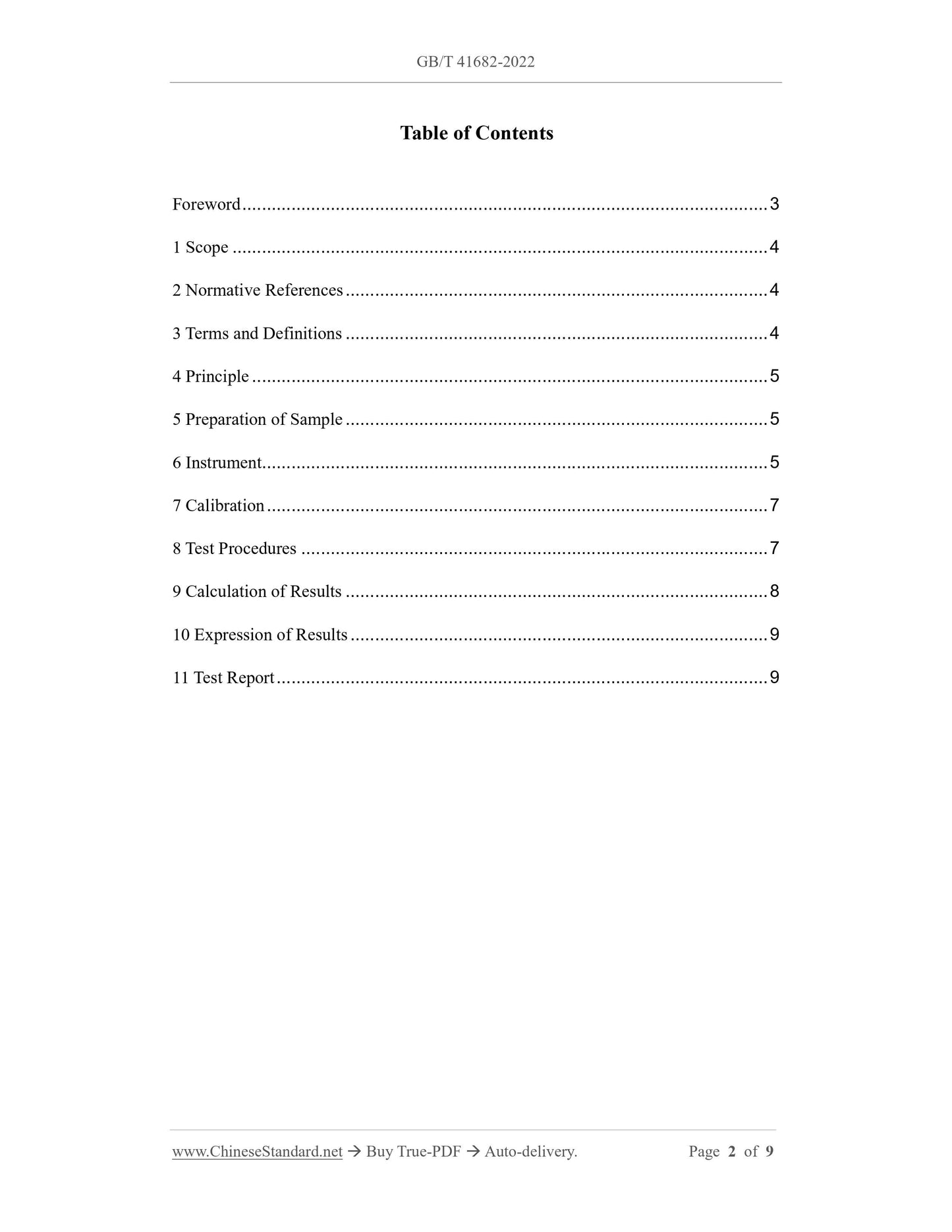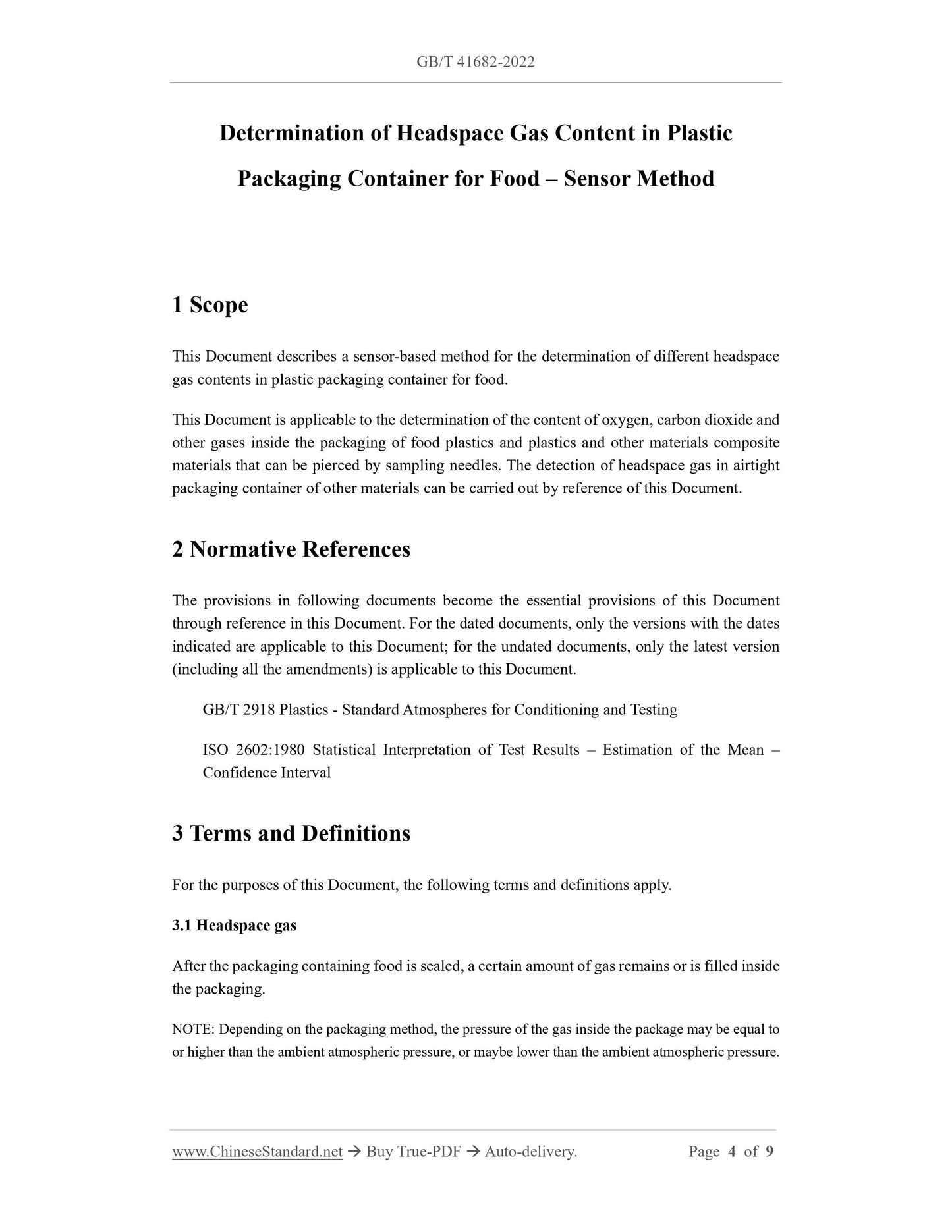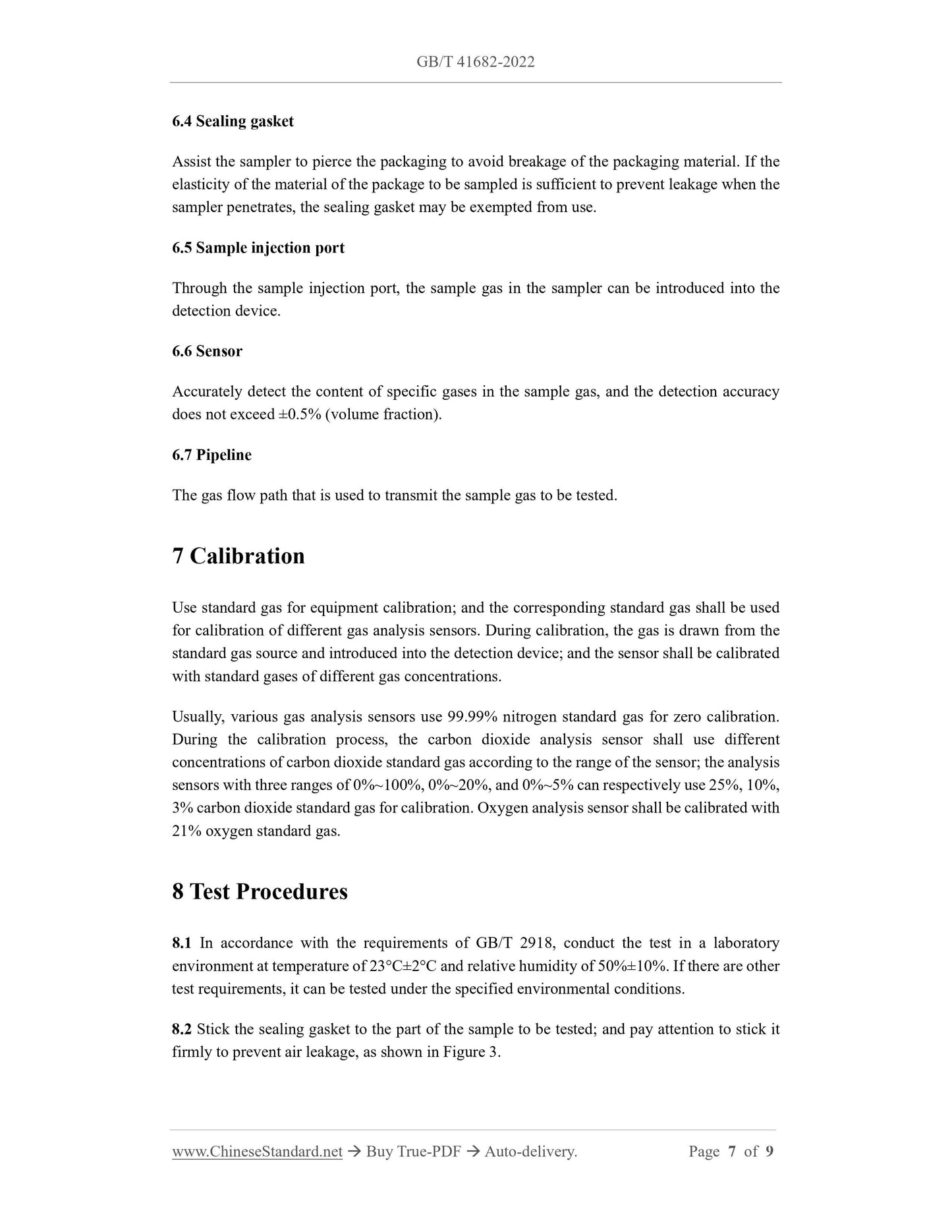PayPal, credit cards. Download editable-PDF & invoice in 1 second!
GB/T 41682-2022 English PDF (GBT41682-2022)
GB/T 41682-2022 English PDF (GBT41682-2022)
Precio habitual
$170.00 USD
Precio habitual
Precio de oferta
$170.00 USD
Precio unitario
/
por
Los gastos de envío se calculan en la pantalla de pago.
No se pudo cargar la disponibilidad de retiro
Delivery: 3 seconds. Download true-PDF + Invoice.
Get QUOTATION in 1-minute: Click GB/T 41682-2022
Historical versions: GB/T 41682-2022
Preview True-PDF (Reload/Scroll if blank)
GB/T 41682-2022: Determination of headspace gas content in plastic packaging container for food -- Sensor method
GB/T 41682-2022
GB
NATIONAL STANDARD OF THE
PEOPLE’S REPUBLIC OF CHINA
ICS 83.140.01
CCS G 31
Determination of Headspace Gas Content in Plastic
Packaging Container for Food – Sensor Method
ISSUED ON: OCTOBER 12, 2022
IMPLEMENTED ON: MAY 01, 2023
Issued by: State Administration for Market Regulation;
Standardization Administration of the People’s Republic of China.
Table of Contents
Foreword ... 3
1 Scope ... 4
2 Normative References ... 4
3 Terms and Definitions ... 4
4 Principle ... 5
5 Preparation of Sample ... 5
6 Instrument... 5
7 Calibration ... 7
8 Test Procedures ... 7
9 Calculation of Results ... 8
10 Expression of Results ... 9
11 Test Report ... 9
Determination of Headspace Gas Content in Plastic
Packaging Container for Food – Sensor Method
1 Scope
This Document describes a sensor-based method for the determination of different headspace
gas contents in plastic packaging container for food.
This Document is applicable to the determination of the content of oxygen, carbon dioxide and
other gases inside the packaging of food plastics and plastics and other materials composite
materials that can be pierced by sampling needles. The detection of headspace gas in airtight
packaging container of other materials can be carried out by reference of this Document.
2 Normative References
The provisions in following documents become the essential provisions of this Document
through reference in this Document. For the dated documents, only the versions with the dates
indicated are applicable to this Document; for the undated documents, only the latest version
(including all the amendments) is applicable to this Document.
GB/T 2918 Plastics - Standard Atmospheres for Conditioning and Testing
ISO 2602:1980 Statistical Interpretation of Test Results – Estimation of the Mean –
Confidence Interval
3 Terms and Definitions
For the purposes of this Document, the following terms and definitions apply.
3.1 Headspace gas
After the packaging containing food is sealed, a certain amount of gas remains or is filled inside
the packaging.
NOTE: Depending on the packaging method, the pressure of the gas inside the package may be equal to
or higher than the ambient atmospheric pressure, or maybe lower than the ambient atmospheric pressure.
6.4 Sealing gasket
Assist the sampler to pierce the packaging to avoid breakage of the packaging material. If the
elasticity of the material of the package to be sampled is sufficient to prevent leakage when the
sampler penetrates, the sealing gasket may be exempted from use.
6.5 Sample injection port
Through the sample injection port, the sample gas in the sampler can be introduced into the
detection device.
6.6 Sensor
Accurately detect the content of specific gases in the sample gas, and the detection accuracy
does not exceed ±0.5% (volume fraction).
6.7 Pipeline
The gas flow path that is used to transmit the sample gas to be tested.
7 Calibration
Use standard gas for equipment calibration; and the corresponding standard gas shall be used
for calibration of different gas analysis sensors. During calibration, the gas is drawn from the
standard gas source and introduced into the detection device; and the sensor shall be calibrated
with standard gases of different gas concentrations.
Usually, various gas analysis sensors use 99.99% nitrogen standard gas for zero calibration.
During the calibration process, the carbon dioxide analysis sensor shall use different
concentrations of carbon dioxide standard gas according to the range of the sensor; the analysis
sensors with three ranges of 0%~100%, 0%~20%, and 0%~5% can respectively use 25%, 10%,
3% carbon dioxide standard gas for calibration. Oxygen analysis sensor shall be calibrated with
21% oxygen standard gas.
8 Test Procedures
8.1 In accordance with the requirements of GB/T 2918, conduct the test in a laboratory
environment at temperature of 23°C±2°C and relative humidity of 50%±10%. If there are other
test requirements, it can be tested under the specified environmental conditions.
8.2 Stick the sealing gasket to the part of the sample to be tested; and pay attention to stick it
firmly to prevent air leakage, as shown in Figure 3.
Get QUOTATION in 1-minute: Click GB/T 41682-2022
Historical versions: GB/T 41682-2022
Preview True-PDF (Reload/Scroll if blank)
GB/T 41682-2022: Determination of headspace gas content in plastic packaging container for food -- Sensor method
GB/T 41682-2022
GB
NATIONAL STANDARD OF THE
PEOPLE’S REPUBLIC OF CHINA
ICS 83.140.01
CCS G 31
Determination of Headspace Gas Content in Plastic
Packaging Container for Food – Sensor Method
ISSUED ON: OCTOBER 12, 2022
IMPLEMENTED ON: MAY 01, 2023
Issued by: State Administration for Market Regulation;
Standardization Administration of the People’s Republic of China.
Table of Contents
Foreword ... 3
1 Scope ... 4
2 Normative References ... 4
3 Terms and Definitions ... 4
4 Principle ... 5
5 Preparation of Sample ... 5
6 Instrument... 5
7 Calibration ... 7
8 Test Procedures ... 7
9 Calculation of Results ... 8
10 Expression of Results ... 9
11 Test Report ... 9
Determination of Headspace Gas Content in Plastic
Packaging Container for Food – Sensor Method
1 Scope
This Document describes a sensor-based method for the determination of different headspace
gas contents in plastic packaging container for food.
This Document is applicable to the determination of the content of oxygen, carbon dioxide and
other gases inside the packaging of food plastics and plastics and other materials composite
materials that can be pierced by sampling needles. The detection of headspace gas in airtight
packaging container of other materials can be carried out by reference of this Document.
2 Normative References
The provisions in following documents become the essential provisions of this Document
through reference in this Document. For the dated documents, only the versions with the dates
indicated are applicable to this Document; for the undated documents, only the latest version
(including all the amendments) is applicable to this Document.
GB/T 2918 Plastics - Standard Atmospheres for Conditioning and Testing
ISO 2602:1980 Statistical Interpretation of Test Results – Estimation of the Mean –
Confidence Interval
3 Terms and Definitions
For the purposes of this Document, the following terms and definitions apply.
3.1 Headspace gas
After the packaging containing food is sealed, a certain amount of gas remains or is filled inside
the packaging.
NOTE: Depending on the packaging method, the pressure of the gas inside the package may be equal to
or higher than the ambient atmospheric pressure, or maybe lower than the ambient atmospheric pressure.
6.4 Sealing gasket
Assist the sampler to pierce the packaging to avoid breakage of the packaging material. If the
elasticity of the material of the package to be sampled is sufficient to prevent leakage when the
sampler penetrates, the sealing gasket may be exempted from use.
6.5 Sample injection port
Through the sample injection port, the sample gas in the sampler can be introduced into the
detection device.
6.6 Sensor
Accurately detect the content of specific gases in the sample gas, and the detection accuracy
does not exceed ±0.5% (volume fraction).
6.7 Pipeline
The gas flow path that is used to transmit the sample gas to be tested.
7 Calibration
Use standard gas for equipment calibration; and the corresponding standard gas shall be used
for calibration of different gas analysis sensors. During calibration, the gas is drawn from the
standard gas source and introduced into the detection device; and the sensor shall be calibrated
with standard gases of different gas concentrations.
Usually, various gas analysis sensors use 99.99% nitrogen standard gas for zero calibration.
During the calibration process, the carbon dioxide analysis sensor shall use different
concentrations of carbon dioxide standard gas according to the range of the sensor; the analysis
sensors with three ranges of 0%~100%, 0%~20%, and 0%~5% can respectively use 25%, 10%,
3% carbon dioxide standard gas for calibration. Oxygen analysis sensor shall be calibrated with
21% oxygen standard gas.
8 Test Procedures
8.1 In accordance with the requirements of GB/T 2918, conduct the test in a laboratory
environment at temperature of 23°C±2°C and relative humidity of 50%±10%. If there are other
test requirements, it can be tested under the specified environmental conditions.
8.2 Stick the sealing gasket to the part of the sample to be tested; and pay attention to stick it
firmly to prevent air leakage, as shown in Figure 3.
Share








